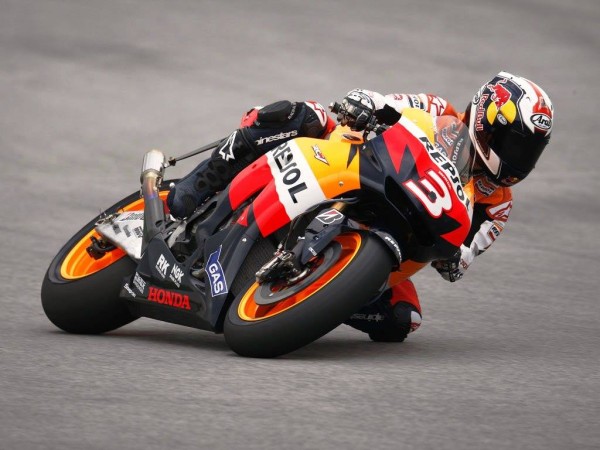Your motorbike handlebars turn left and right. To a person that doesn’t ride it seems obvious that to steer left you turn the bars to the left, and vice versa. However, this isn’t the case once you are moving above around 10mph. The reason is that there is a gyroscopic effect caused by your wheels, called precession, which makes them want to spin in one plane and resist changing to other planes, and there’s also the inertia of you and your bike. This means the only way to make a rapid turn when travelling at speed is by countersteering.
Even at speeds of under 10mph you are using countersteering to some extent, but this tends to be masked by being a bit ‘wobbly’ at low speeds – you’ll be making many minor balance corrections with the handlebars. At higher speeds you must deliberately use countersteering, also called positive input or positive steering, to turn.
Essentially you are steering left to turn right.

At racing speeds it’s impossible to turn tight corners without countersteering
To force a motorbike to turn, the combined centre of gravity of the rider and the bike must be on the side the rider wants to turn towards. The bike will lean into the turn and the rider will use the handlebars to maintain the angle of the lean. The speed of the bike affects the angle at which the bike needs to be laid over, and the bike is in balance when the centripetal and gravitational torque in relation to the speed at which the wheels are turning are equal.
Here’s how countersteering works
To begin a right hand turn you must get the motorbike to lean to the right. The quickest way to do that is provide some positive input (positive steering) by pushing the right handlebar forwards briefly. This alters the centre of balance of the bike by causing a slight deviation to the left. This causes the bike to tip to the right, setting it up for a right-hand turn. The rider then adjusts the angle of steering input to keep it in balance.
At lower speeds it is more necessary to maintain some opposite steering to maintain the turn, but at higher speeds this gradually changes in to the need to steer in the same direction as the turn.
Countersteering is a natural action that you don’t need to think about. I learned it on a 50cc scrambler on holiday in Wales. When the bike didn’t respond like my Raleigh BMX, I quickly found out how to turn and then it felt natural; you don’t really think about how it works as a kid.
With a lighter bike (like the 50cc scrambler, but also many of the learner-approved motorbikes), you can turn just by shifting your weight, but you can’t turn quickly. This technique is also not effective on larger motorbikes which have much more forwards momentum.
Countersteering is something you must practise because you will need it in emergency situations. Make sure it’s second-nature to you to use countersteering to make rapid changes in direction.
This video from Roadcraft in Nottingham explains it well.
